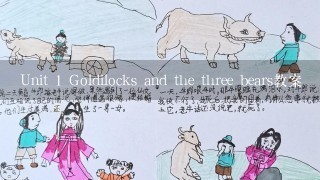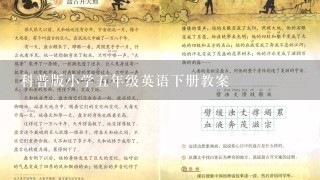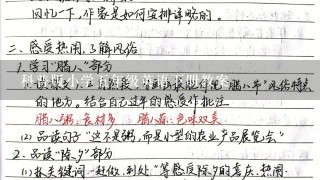Unit 1 Goldilocks and the three bears教案,Unit 1 Goldilocks and the three bears教案

1、Unit 1 Goldilocks and the three bears教案
去百度文库,查看完整内容> 内容来自用户:angel320982 Unit 1 Goldilocks and the three bears 单元教材分析: 本单元主要话题是谈论房屋、住所和居室及房屋内物品的陈列。课文通过学生熟悉的中文版三只熊的趣味故事帮助学生理解英文文本、学习方位介词以及帮助学生理解There be…句型。教师可以充分利用书本材料进行教学与操练,也可以让学生们用身边的物品进行对话交流,或在具体的情境下(例如自己的房间、学校、自己熟悉的场所)谈论物品陈列。本单元中,教师可引导学生结合以前学过的地点类词汇和方位介词进行表述。在教学过程中,教师也可以提前渗透There be…句型的一般疑问句,为第二单元做铺垫。在实际操练过程中可能会提及There be…句型的就近原则,教师也可以适当讲解。五年级相对于三四年级的教材又增添了2个新的学习版块:Grammar time和Culture time.在第一单元的教学中老师要继续注重培养学生的学习兴趣,重视激发和保护学生学习英语的热情,培养学生运用所学英语进行交际的意识和勇气。单元教学目标:知识目标
1、在课文情景中学生能够听懂、会说、会读故事中出现的词汇:Goldilocks, bear, forest, house, soup, hard, soft, afraid, just right, in front of;
2、基于三只熊的故事,在故事情景中反复使用、巩固there be句型;
3、创设不同情境,让学生能够听懂、会说、会读、会写句型:第第第。

2、Unit 1 Goldilocks and the three bears教案
去百度文库,查看完整内容> 内容来自用户:angel320982 Unit 1 Goldilocks and the three bears 单元教材分析: 本单元主要话题是谈论房屋、住所和居室及房屋内物品的陈列。课文通过学生熟悉的中文版三只熊的趣味故事帮助学生理解英文文本、学习方位介词以及帮助学生理解There be…句型。教师可以充分利用书本材料进行教学与操练,也可以让学生们用身边的物品进行对话交流,或在具体的情境下(例如自己的房间、学校、自己熟悉的场所)谈论物品陈列。本单元中,教师可引导学生结合以前学过的地点类词汇和方位介词进行表述。在教学过程中,教师也可以提前渗透There be…句型的一般疑问句,为第二单元做铺垫。在实际操练过程中可能会提及There be…句型的就近原则,教师也可以适当讲解。五年级相对于三四年级的教材又增添了2个新的学习版块:Grammar time和Culture time.在第一单元的教学中老师要继续注重培养学生的学习兴趣,重视激发和保护学生学习英语的热情,培养学生运用所学英语进行交际的意识和勇气。单元教学目标:知识目标
1、在课文情景中学生能够听懂、会说、会读故事中出现的词汇:Goldilocks, bear, forest, house, soup, hard, soft, afraid, just right, in front of;
2、基于三只熊的故事,在故事情景中反复使用、巩固there be句型;
3、创设不同情境,让学生能够听懂、会说、会读、会写句型:第第第。

3、科普版小学五年级英语下册教案
教学目标:
1、掌握“How many…...are there?”句型,并能熟练运用。
2、理解并知道名词的复数形式,并能记住一些常见的名词复数。
3、词汇:sheep,children,flowers,butterflies,dogs,ducks,chicks,rabbits,mice,birds,bears,hens. 教学重难点: 理解并记住一些常见名词的复数形式。 操练方式: 任务教学法,小组合作,活动课形式,机械操练和英语游戏相结合。 教学程序: Step
1、 Warm up
1、 Enable children say the chant of Unit 3 Page
18、
2、 Check the children’s homework. Step
2、 Presentation
1、 Teacher draw a flower on the blackboard and say: “It’s a flower. ”and draw other flowers and say: “two flowers, three flowers…” Let children understand the plural forms of noun.
2、 Write the following words on the blackboard and let children read and repeat 。(同时播放本单元课件,让学生感知和理解名词的复数形式。) Sheep_sheep child_children flower_flowers dog_dogs butterfly_butterflies duck_ducksc chick_chicks rabbit_rabbits mouse_mice bird_birds bear_bears hen_hens
3、 Let children to repeat the words after the tape, and then let some children to read one by one. Step
3、 Practice
1、 Play the cassette, children follow the tape to sing together. And then let children to have competition in groups.
2、 Give children several minutes to find the words in part 3, praise those excellent students with prizes.
3、 Finish the exercises: Let children join the dots and colour it.
4、 Play the cassette, ask children to listen and circle the correct answer, and then tell them the answer. Step
4、 Exercises
1、 Read and act the dialogue in groups or in pairs.
2、 Pronounce the words, and ask children to read one by one。

4、科普版小学五年级英语下册教案
教学目标:
1、掌握“How many…...are there?”句型,并能熟练运用。
2、理解并知道名词的复数形式,并能记住一些常见的名词复数。
3、词汇:sheep,children,flowers,butterflies,dogs,ducks,chicks,rabbits,mice,birds,bears,hens. 教学重难点: 理解并记住一些常见名词的复数形式。 操练方式: 任务教学法,小组合作,活动课形式,机械操练和英语游戏相结合。 教学程序: Step
1、 Warm up
1、 Enable children say the chant of Unit 3 Page
18、
2、 Check the children’s homework. Step
2、 Presentation
1、 Teacher draw a flower on the blackboard and say: “It’s a flower. ”and draw other flowers and say: “two flowers, three flowers…” Let children understand the plural forms of noun.
2、 Write the following words on the blackboard and let children read and repeat 。(同时播放本单元课件,让学生感知和理解名词的复数形式。) Sheep_sheep child_children flower_flowers dog_dogs butterfly_butterflies duck_ducksc chick_chicks rabbit_rabbits mouse_mice bird_birds bear_bears hen_hens
3、 Let children to repeat the words after the tape, and then let some children to read one by one. Step
3、 Practice
1、 Play the cassette, children follow the tape to sing together. And then let children to have competition in groups.
2、 Give children several minutes to find the words in part 3, praise those excellent students with prizes.
3、 Finish the exercises: Let children join the dots and colour it.
4、 Play the cassette, ask children to listen and circle the correct answer, and then tell them the answer. Step
4、 Exercises
1、 Read and act the dialogue in groups or in pairs.
2、 Pronounce the words, and ask children to read one by one。





































































